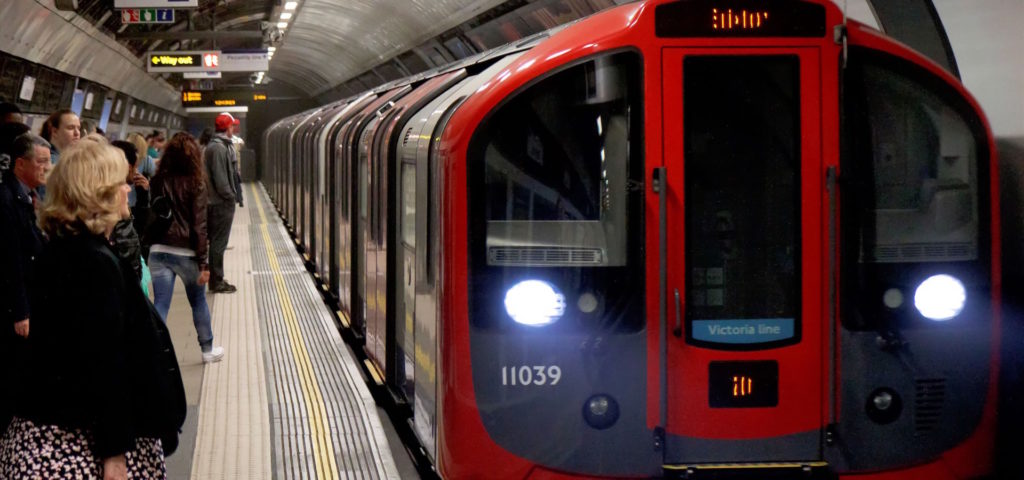London’s mayor Sadiq Khan has announced an ambitious new goal of a zero-emissions transport network by 2050. And not a moment too soon – London has been facing emergency air quality alerts and high pollution this past month. James Murray investigates.

Wide-ranging new strategy promises huge expansion of cycle network and the delivery of a zero emission transport network (Photo by Tom Page, edited, CC BY-SA 2.0)
With perfect timing, the unveiling of the Mayor of London’s wide-ranging new transport strategy coincided with the triggering of an emerging air quality alert, prompted by high temperatures and southerly winds that sent air pollution levels soaring.
The alert saw warnings displayed at bus stops, on road signs, and on the underground network across the capital.
The warning came as Mayor Sadiq Khan unveiled a new draft Transport Strategy, which aims to build on his recent commitment to expand the green bus network, introduce a ‘Toxicity-charge’ for the most polluting vehicles, and deliver a low emission taxi fleet.
The long term plan sets a target of increasing the proportion of people walking, cycling and taking public transport to 80 per cent of all journeys by 2041, up from 64 per cent currently.
The target would reduce the average number of car journeys each day by three million, even as the city’s population is projected to climb from 8.7 million to 10.5 million over the next 25 years.
It is accompanied by a new goal to ensure London’s entire transport network is zero emission by 2050.
To help deliver on the goals, the plan promises to significantly extend the cycle route network so that 70 per cent of Londoners to live within 400 metres of a high quality, safe cycle route by 2041.
It also includes proposals to deter car ownership by restricting car parking provision within new developments, providing more secure cycle parking and storage, and ensuring that where car parking is considered appropriate, provision is made for electric vehicle charging points.
The publication of the new strategy came on the same day as the government announced in its Queens Speech that it would introduce a new Electric and Autonomous Vehicle Bill that will require services stations and some petrol stations to provide electric vehicle charging infrastructure.
In addition, Khan said the new plan would see Transport for London explore the potential for a new generation of more sophisticated road charging scheme, which could include per mile charges.
“It has been an incredibly difficult few weeks for London, but we must carry on as a city and that means pushing forward our work to keep Londoners moving around our city,” Khan said. “As London’s population is set to increase beyond 10 million, our future health and prosperity is more and more dependent on us reducing our reliance on cars. We have to be ambitious in changing how our city works.
“While there will be five million additional journeys being made across our transport network by 2041, at the same time we’re setting ourselves a bold target of reducing car journeys by three million every day.”
Khan was unapologetic about the need to curb car use, despite the fact some of the proposals are likely to face opposition from motoring groups. “We have to make not using your car the affordable, safest and most convenient option for Londoners going about their daily lives,” he said. “This is not only essential for dealing with congestion as London grows, but crucial for reducing our toxic air pollution, and improving the health of all Londoners.”
The draft plan is backed by £2.1bn of funding that has already been allocated to a new TfL Healthy Streets Portfolio, which aims to create more “welcoming and inclusive streets to enable more Londoners to walk, cycle and use public transport”.
The plan also includes a series of proposals to expand the Tube and rail network and step up investment in low emission buses, as the Mayor’s Office continues with its plans to tackle air pollution, carbon emissions, and overcrowding on public transport.
“This ambitious, well-thought-through long term vision for the London transport system is very welcome,” said Paul Morozzo, clean air campaigner at Greenpeace. “Investing in public transport, walking and cycling is crucial to solving the air pollution problem effectively. We also look forward to the Mayor’s initiatives in the short term which will improve air quality by helping to phase out the diesel vehicles responsible for much of the roadside pollution blighting our city and expanding the ultra-low emissions zone. London is a city at the cutting-edge of so many fields – let’s turn it into a clean transport leader too.”
This article was originally published at Business Green.
James Murray is the editor-in-chief of BusinessGreen having launched the site in October 2007.
A walk in (central) London shows that much of the problem is not private cars – but mostly vans, lorries and buses. It is these groups that need to be regulated. Furthermore, it us mostly commercial vehicles that are responsible for the deaths of cyclists.